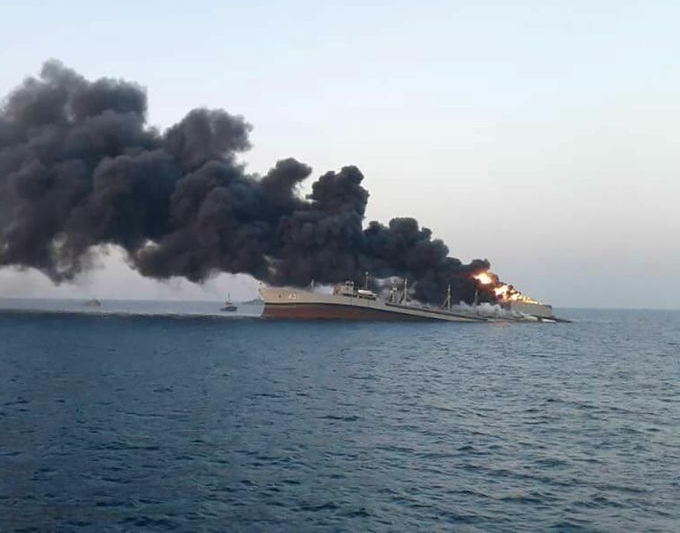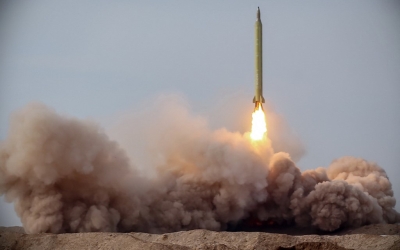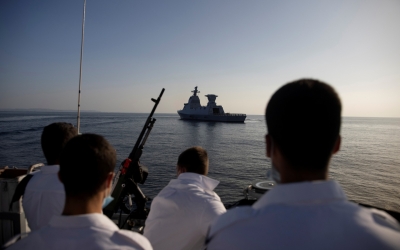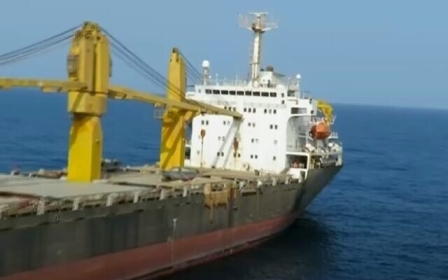Iran: Huge naval vessel sinks in Gulf of Oman after catching fire

One of Iran's largest naval ships sank on Wednesday after catching fire while on a "training mission" off a strategic port near the head of the Gulf of Oman, the navy said.
The British-built fleet replenishment vessel Kharg, which measured more than 200 metres long, caught fire on Tuesday off the port of Jask, the navy said.
Footage aired by state television showed a massive column of smoke rising from what it said was the burning vessel.
The fire broke out in "one of the systems" of the ship, according to the navy. Firefighting efforts continued "for 20 hours" before the ship went down.
"Considering the spread of the fire, the mission to save the Kharg failed and it sank in waters off Jask," said the navy.
The ship caught fire at 11am (06.30 GMT) on Tuesday while it was in "domestic waters" during "a training mission", Iran's Tasnim news agency quoted the navy's head of public relations, Behzad Jahanian, as saying.
It sank at around 8.30am (04.00 GMT) on Wednesday. All 400 cadets and crew disembarked safely, with 20 sustaining light injuries or burns.
Jahanian said the cause of the fire was "still not clear".
'Useful asset'
The vessel was ordered from Britain in 1976, when the pro-Western shah was still in power. It was not delivered until 1984, after years of wrangling between Britain and the government that took power in Tehran after the Islamic revolution of 1979.
Jeremy Binnie, of open-source defence intelligence provider Janes, told AFP the Kharg was important to Iran as its only dedicated vessel able to resupply warships at sea.
"The Iranians often describe it as a 'helicopter carrier', but it is actually a replenishment ship - a useful asset nonetheless, as it was the Islamic Republic of Iran Navy's (IRIN) only dedicated ship serving this role," Binnie said.
"It is not the IRIN's largest vessel any more, after they commissioned Makran, a converted oil tanker, in January," he added.
Iran's ISNA news agency said the vessel had left for a mission focused on "training, intelligence and combat" alongside the destroyer Alborz on 19 May.
Strategic waters
The port city of Jask, near to which the Kharg went down, lies close to the Strait of Hormuz, the strategic chokepoint at the head of the Gulf through which a fifth of the world's oil output passes.
Jask is strategically important to Iran, as the government plans to make it the site of the country's second-largest oil export terminal.
An approximately 1,000km pipeline from Bushehr province on the Gulf to Jask was put into service a few days ago, the government said. It provides a new route for Iranian oil exports that bypasses the Strait of Hormuz.
Last year, an Iranian warship was hit by "friendly fire" during a naval exercise off Jask, killing the 19 sailors on board. The logistical support vessel Konarak was hit after "moving a practice target to its destination and not creating enough distance between itself and the target," state television said at the time.
Tit-for-tat attacks
In recent months there have also been reported attacks on Iran's shipping fleet that have been linked to its regional rival, Israel.
In April, Tehran said its freighter Saviz was hit by an "explosion" in the Red Sea, after media reports said Israel had struck the ship.
The New York Times reported at the time that the Saviz had been targeted in an Israeli "retaliatory" attack after "Iran's earlier strikes on Israeli ships".
It came at a time of heightened tension between the two countries, with reports of tit-for-tat attacks on shipping since early March.
Middle East Eye propose une couverture et une analyse indépendantes et incomparables du Moyen-Orient, de l’Afrique du Nord et d’autres régions du monde. Pour en savoir plus sur la reprise de ce contenu et les frais qui s’appliquent, veuillez remplir ce formulaire [en anglais]. Pour en savoir plus sur MEE, cliquez ici [en anglais].






